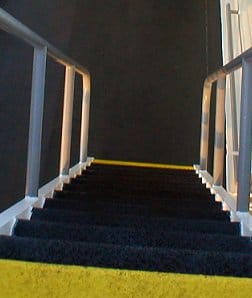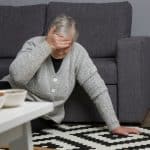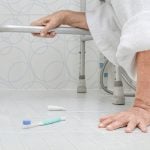Falls are a major public health concern for older Americans, and many of these falls occur where you feel that you should be the safest: in your own home. These falls are often due to hazards that can be easy to overlook, but most are simple to fix. There are a variety of steps that you can take to ensure that you remain safe from falls at home.
Fall Statistics
In the U.S., falls are a major problem with adults over the age of 65, and injuries like head trauma and hip fractures are common. One out of three older adults will fall each year, and in 2013 alone 2.5 million nonfatal falls were treated in ER departments. More than 725,000 of these patients required hospitalization.
Unfortunately, a single fall can make it difficult for a senior to return home and live independently. About one out of four people who fall will suffer moderate to severe injuries, and these injuries can make it hard to get around or return to their homes. A majority of fractures among seniors are caused by falls, including fractures of the hip, pelvis, arm, forearm, and leg, and a break can severely hinder an older adult’s ability to properly care for themselves upon returning home.
Fall Prevention Steps
As you age, health conditions and physical changes make falls more likely. In fact, falls are the top cause of injury among senior citizens. Despite this concern, the fear of falling doesn’t need to rule your life, and by taking a few fall prevention steps you can work to reduce your risk:
-Talk to your doctor. Your fall prevention plan should start with your physician. During your appointment, you can review your medications and medical conditions to see if any may increase the likelihood of a fall.
-Invest in sensible footwear. Consider buying new shoes as part of your fall prevention plan. Shoes with slick soles, high heels, and slippers could cause you to trip, slip, and fall, as can walking around in just your socks. Instead, choose sturdy shoes that fit properly and have nonskid soles.
-Remove hazards in your home. Secure loose rugs, make repairs to flooring, and reduce clutter in order to decrease your risk of tripping and falling.
-Improve the lighting in your home. Keeping your home brightly lit will help you to avoid tripping on objects. Get support from your family. Enlist support from your loved ones in order to take steps to stay safe.
Fall Prevention Checklist
As previously noted, making changes to your home is an essential step in preventing falls at home. Use the following checklist to eliminate
some of the most common fall hazards in each room of your home:
Living Room
–Ensure that the seating is safe and that you can get in and out of furniture easily.
–Make sure walkways are clear of cords, clutter, and electrical wires.
–Be sure that light switches are easily accessible at the entrance to the room.
–Remove floor rugs, which are common tripping hazards.
–Hang lightweight shades or curtains to reduce glare from outdoor light.
–Swap out old, dull light bulbs for brighter fluorescent lighting
Kitchen
–Move items that you will use most frequently to lower shelves that you can reach without the use of a step stool.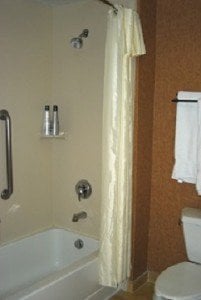
–Never stand on a chair or a step stool, and if you need help reaching something, ask for help.
–Ensure that floor surfaces are non-glare and not slippery.
–Always keep cabinet doors and drawers closed when you are not using them.
–Wipe up liquid spills or grease right away in order to prevent slips.
Bathroom
–Place self-stick strips or a non-slip rubber mat on the floor of the shower or bathtub.
–Have grab bars installed next to the toilet and inside of the bathtub.
–Consider placing a bath chair in the shower so that you can sit while bathing.
–Place a phone in the bathroom that is easily accessible from the floor.
–Choose an elevated toilet seat that will give you better leverage to get into a standing position.
Bedroom
–Place a nightlight in the hallway outside of your bedroom to make it easy to see in the dark.
–Be sure that the pathway from your bed to the bathroom is properly illuminated and clear of clutter.
–Place a lamp on a bedside table so that you can reach it without getting up out of bed.
–Have a telephone on your bedside table so that you can access it without getting up out of bed.
–Make sure there is somewhere to place your glasses that will be easy to reach without getting out of bed.
–Be sure that all stairways are well lit.
–Never leave items on the stairs that could become tripping hazards, like laundry, shoes, or books.
–Have any loose or broken steps repaired immediately.
–Fix any loose or broken handrails.
–Add non-skid strips to stairs to improve your traction and footing.
–Paint a colored strip on the bottom and top steps.
Tips and Advice
In addition to the changes 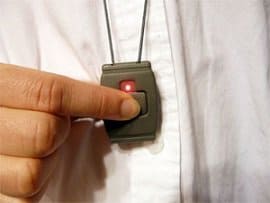 that you’ve made to your home, there are other steps that you can take to be proactive in your quest to prevent a future fall:
that you’ve made to your home, there are other steps that you can take to be proactive in your quest to prevent a future fall:
–Get regular exercise, as exercise will improve your coordination and balance while strengthening your muscles.
–Always get up slowly after sitting or lying down in order to prevent dizziness.
–Visit the optometrist annually, as poor vision can lead to falls.
–Make sure you have a flashlight with fresh batteries placed in the living room, kitchen, and bedroom in case of a power loss.
–Walk with aids like a cane or walker, if necessary.
–Avoid alcohol if you notice that drinking affects your balance.
–Keep emergency phone numbers printed in a large font near each phone.
–Consider investing in a Lifeline or other personal emergency response device in order to call for help in the event of a fall. Read our Lifeline reviews to learn more.

